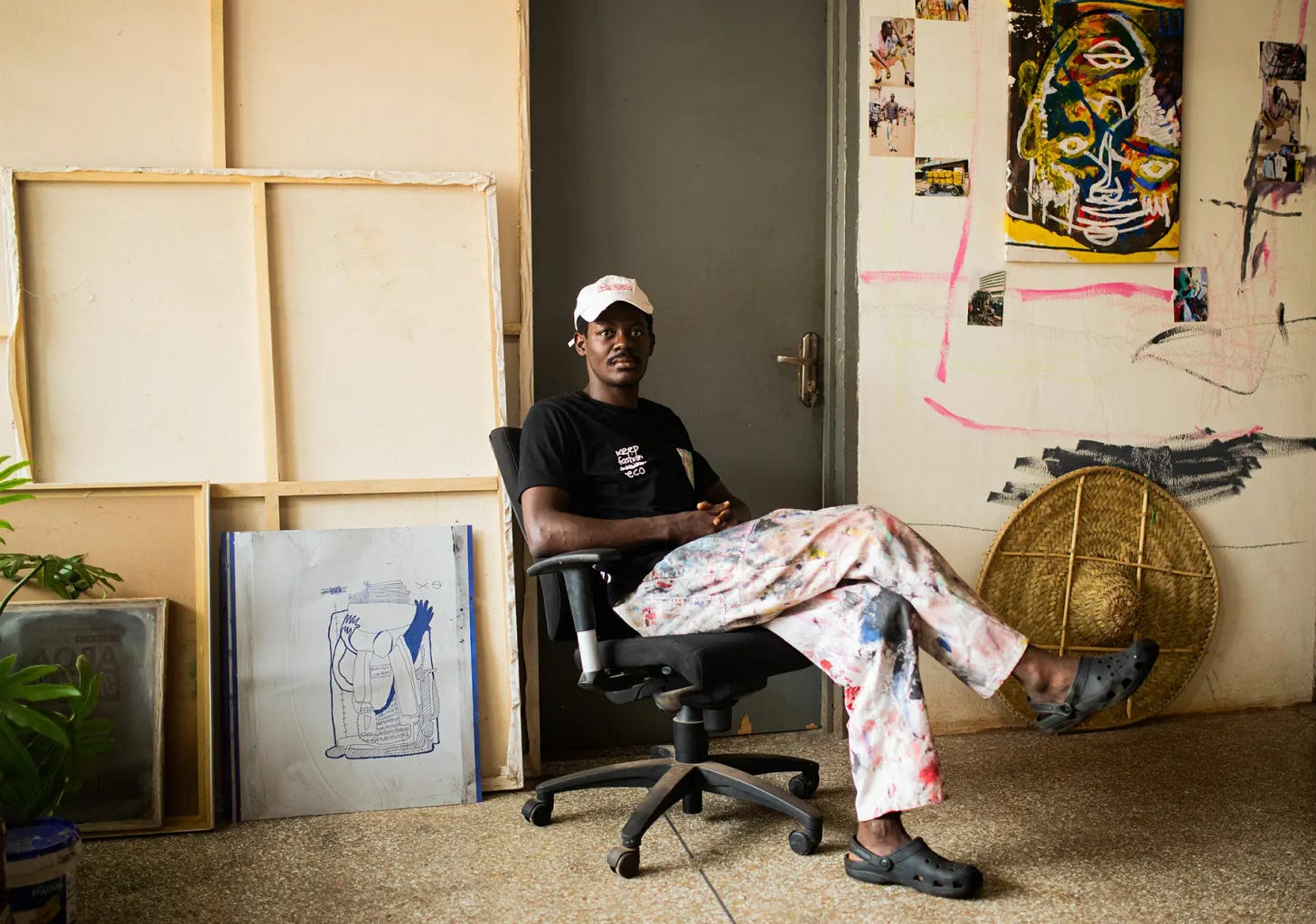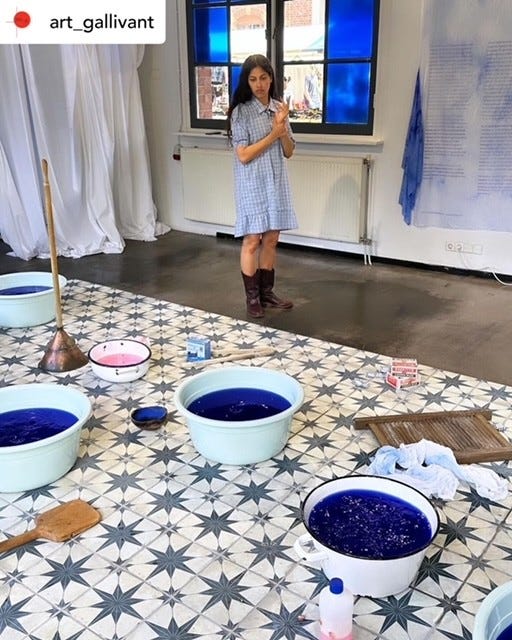I've been increasingly pondering the role of art in a world that feels like a "Black Mirror" episode every day. This year, Amsterdam Art Week ran from May 29th to June 2nd, and I hoped it would provide an opportunity to explore the relationship between art and our current lives. I reflected on the meaning-making in art and was curious how much the work would reflect the current truths.
Since its inception in 2011, Amsterdam Art Week has transformed the city into a vibrant meeting place for (inter)national artists, art lovers, professionals, and collectors. Simultaneously, many gallery spaces host events and special exhibitions for the public for a week, mostly free.
Many of my favourite artworks from last week's explorations reflect my initial "and what about it?" sentiment. Although I remain unsettled, these pieces showcase unseen beauty, untold stories, and the craft of 1ghetto visualization. The latter, especially, resonates with my frustrations and reflections on our times, unveiling the hidden and questioning the psyche of our society.
Leading question: is everything okay at home? not really no (_British accent)
Episode 1: Selinam Kofiga Gbemu
Ghanaian-based designer and multidisciplinary artist Selinam Kofiga Gbemu, also known as kumfodomfo works on how sustainability goes beyond sustainable collections and focuses on sustainable relationships. He questions if people still have a relationship with their clothing. To unpack the complex transformations brought on by the secondhand trade, in 2019 Kofiga founded The Slum Studio, a self-defined research brand creating hand-painted textiles and one-of-a-kind upcycled garments—buttoned shirts and loose trousers, covered in symbols, writing, and radiant strokes of colour.
I was meant to go to a talk by the founder on why sustainable fashion goes beyond clothing, but I couldn’t attend. Like many other events that weekend, I missed it. But serendipitously came across his work in the Stedelijk museum collection and wow. How brilliant it was to see this work in person. The garments are vibrant, worn and created with such detail. There is also a beautiful emphasis on the wear of clothes and not just the function or extension of persona- in this case, an artist is constantly in contact with colour.
Consumption vs Curation
This work is highly relevant as we live in a heavily consumption-based society, where “the currency has become also your ability to consume-as lifestyle being flaunted, purchase power is hype”.
Although there are many ways to express yourself without spending, consumption has become the go-to method for bypassing the process of cultivating a lived and embodied life. For instance, instead of taking up tennis, you can wear tennis attire and call it a day, using fashion to reimagine who you can be. Clothes have become a commodity, and consumption has become the currency for portraying coolness. The haul is not about the outfits; but the act of consumption and the ability to pay. You're not merely wearing the clothing— even sustainable new clothing can wear you if the ethos remains the same.
Similarly, this work reminded me of a book by Alec Lech on overconsumption and our relationship to fast fashion. According to Leach, we have found ourselves buying clothes to reflect our hopes and dreams, and in doing so we fail to recognize the immense destruction being done behind the curtain. Mass production even allows us to disassociate from the production cycle, labour and the adverse consequences of this production-we see what we want to see. And the “Made in” label is a lie that depends on how the company narrate their “sustainability story. He suggests creating a relationship with your clothes and personal needs, this may halt the cycle of avoidance and denial.
Kofiga’s work is a material investigation of waste and radical reframing of upcycling as both a creative and a political act. His work is currently part of the Tomorrow is a Different Day collection at Stedelijk Museum, Amsterdam.
Book rec: The world is on fire but we’re still buying shoes by@alecleach
Episode 2: Kevin Osepa
Kevin Osepa (Curaçao, 1994) is a visual artist working with film and photography, delving into themes of Afro-spirituality, queerness, and colonial history. Through personal and generational stories, he confronts rituals and mysticism to encourage collective healing.
Osepa's work is mystical and directly engages with spirituality while demystifying colonial myths. In this work, he processes Reckitt’s Crown Blue Squares, or blous as it’s known in Curaçao. It was initially produced to whiten laundry, but its vibrant blue pigment has been adopted into several Afro-Caribbean rituals, including 2brua. He grew up listening to stories of his mother and grandmother bathing and covering him in 3blous-Reckitt’s blue to protect me from the evil eye, which he believes may explain his special connection to this spiritual ritual and why it’s played a central role throughout his work.
I was lucky to speak to Kevin, who was in the space during the openings of the4Keti Koti Festival on 2nd June. For context, Keti Koti, celebrated on July 1st, commemorates the abolition of slavery in 1863. I congratulated him on this work, which is so closely connected to his community. The exhibition was held in Oosterpark, Amsterdam, as part of the festival which is on in the lead up to the 1st of Juli
Encountering such work reaffirms the profound connection between art, community, and culture. They are intertwined and can truly touch the public when combined. The response from almost every person with a non-colonial background was one of recognition, discovery, familiarity, and true demystification. The artist was often summoned to talk about the cultural significance of this ritual. "Hi, I've always wondered where this ritual came from," lamented one visitor. Inviting me to join the conversation, he asked if I was familiar with the ritual. I sadly declined but eavesdropped on the unpacking. Exploring these themes within a community is powerful and gives art a significant role, especially within communities that are socially distant from creative spaces.
This tailored context brought up questions around the traditional placement of art, categorizing for me a new wave of artists including research and Indigenous discovery in their practice. In this recognition, I’m experiencing a shift in what I see as art, questioning space and time and, most relevantly, whose stories are important and to whom they're told.
In this case, the visual triggered so much context already that this familiarity was audible. It captured the audience's conversation in a way mainstream art might not. Telling historically entangled stories is a celebration of Indigenous culture, but it also meaningfully takes part in a live process of the present-day remaking of memories. With Keti Koti as a stage of reinvention, an (unofficial) commemoration day, the community actively revisits and reform memories.
Osepa’s work is housed in prestigious collections such as the ING Collection, the Rijks collection, and the collection of museum Boijmans van Beuningen. Notably, he was nominated for the Volkskrant Fine Art Prize and awarded the Golden Calf for Best Short Film at the Netherlands Film Festival in 2022.
Episode 3: Ehsan Fardjadniya and Raul Bilal
Edgelanders, the project by @ehsan_fardjadniya & @raulbalai seeks justice and demands imagination. In Edgelanders, the duo are constructing a people’s tribunal against the city of Amsterdam, to hold the city government accountable to its ethical image and legal obligations. With this long-term project, they plan to build a case against the city by gathering evidence, hearing witness testimonies, and formulating the indictment for submission in 2025. Hosted by De Appel in Pt 3 - The Witnesses “5undocumented” migrants and a lawyer, zoom in on the experiences of living in a municipal shelter under conditional guidance towards departure to the homeland.
This work exemplifies action-led art that resonates with my imagination—revolutionary imagination. For me, revolutionary imagination means transcending (capitalist)realism. Identifying intersections for systemic change but also embracing new ideological frameworks. I think that the allure of socialism lies not in the miraculousness of the new system but in people's willingness to think beyond the constraints of the current system and the urgency to replace the existing one. The future thinking I contemplate envisions a world where ideas are not prematurely killed before they exist.
So much of the work of oppression is about policing the imagination.
— Saidiya Hartman
I appreciated that the work didn't dwell on the "practicalities" of asylum laws and a bandaid charity mindset but rather asked the audience: "Is this normal?" These stories demonstrate that shelter is a human right. So, what actions should we take? The undocumented persons in the documentaries shared their stories of being caught in the system's impossibilities, violating their rights. Yet the West has established an ambitious framework of human rights. What do we do when the system cannot uphold our moral standards?
There is a real harmony between action and art in this project that I respect, blurring the lines between current doom and demanding reality to figure itself out, both legally and morally. With the genocide in Gaza and many other wars against humanity in mind, the question of solidarity has come up, highlighting the need for an action-based reality. Beyond the teach-ins, I see space for revolutionary imagination that demands principled practice.
Episode 4: Gilleam Trapenberg
Sure, at this point, any visualization of the sun is captivating, but it's not just due to a lack of serotonin, I promise. Visual artist Gilleam Trappenberg (1991)was Born and raised in Curaçao and now lives and works in Amsterdam, the Netherlands. His photography showcases vibrant life in Curaçao, the images are bold, and beautiful and offer an alternative representation and imaging of the Caribbean.
The Right to Beauty as an Element of Social Justice
I detest the use of alternative representation here without commenting on the fact that different realities exist, it is rather the lack of a multidimensional representation that is a problem. I wish not merely to praise artists who visualise what exits but to question forces endorsing collective amnesia and alternative histories- pretty ghetto no?

The intention to capture beauty is clear in this photo series, this choice feeds into the idea that access to beauty, whether in the form of art or architecture, should be considered a fundamental aspect of human well-being or even a component of social justice. The contrast of ghetto visualisation highlights the role of aesthetics in promoting social justice, demonstrating how capturing beauty can benefit entire communities.
Trapenberg's work also exhibited in the context of the Keti Koti Festival searches beneath the portrayals and tropes of Caribbean life that dominate (Western) media cycles, using imagery to develop necessary counter-images. Even the suns captured through Gilleam's lens were carefully documented during his stays in Curaçao. This work was accomplished through digital manipulation, adjusting colours and tones in the negatives.
In 2020, I came across the work of Trapenberg as part of the Presence of Absence exhibition at the Stedelijk Museum. This exhibition was what rekindled my interest in art. I found the works displayed truly iconic and connected to realities. Many of the pieces from this show are now part of the Stedelijk collection, and include some of my favourite impactful makers.
"Ghetto" refers to an area of a city where people of a particular race or religion live closely together and apart from other people. I’m using ghetto visualization to highlight the practice of telling unique stories of such communities and the negative connotations associated with these areas, to comment on the general state of affairs in the world. We can extend this expression to more privileged spaces and the world at large. I often refer to the Netherlands as "ghetto central," with Amsterdam as its capital, because there’s a lot to unpack here. What initially seems harmonious is much more complex and turbulent.
Brua is an umbrella term for witchcraft, superstition, quackery, spirit teachings, scare tactics and scams involving secrecy
Keti Koti means Broken chains












